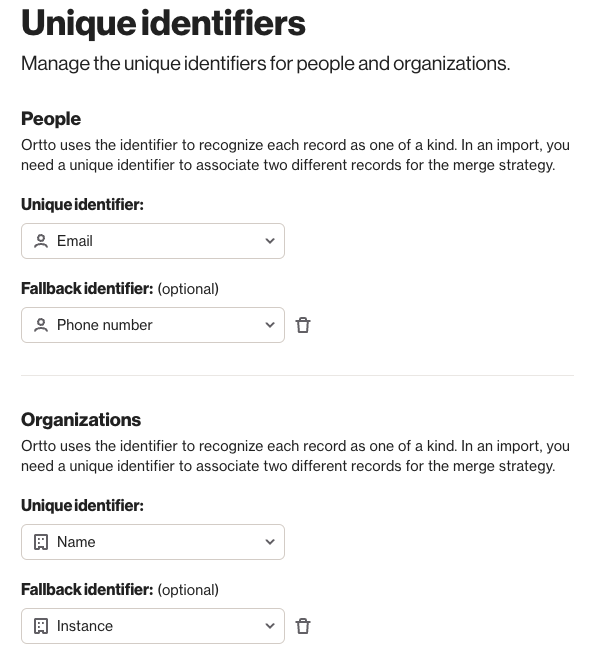Unique identifiers
Overview
Ortto’s Unique identifiers enable users to manage the recognition of each individual person and accounts (previously organizations) record within their Ortto account’s customer data platform (CDP), including those integrated from data sources. These identifiers help Ortto distinguish between unique records and duplicates when importing people (contacts) and accounts (previously organizations).
Accessing unique identifiers
To access the unique identifier page, go to Settings > Customer data > Unique identifiers
Managing unique identifiers
The unique identifiers page allows users to:
How do unique identifiers work?
Ortto initially designates Email as the primary identifier for contacts, with no fallback identifier.
During the import of contacts, Ortto cross-references incoming records with those already present in your CDP. For instance, using the default criteria:
- Does the incoming person's Email match an existing record?
If no match is detected, the incoming contact is appended as a new record to your CDP. However, if a match is found, it will be merged based on the merge strategy you have chosen for that incoming data source.
Set unique identifiers
- Navigate to the Unique identifiers page.
- Choose up to two unique identifiers for each people and accounts (previously organizations) record, including an optional secondary identifier for both the primary and fallback identifiers. Options for identifiers include Ortto’s system fields, fields from integrated data sources, or custom fields.
- Eligible fields for unique identifiers must be text-type (string) or a phone number.
- Learn more about supported Field types.
- Use the Trash icon to remove the optional second identifier if needed.
TIP: Consider the following when selecting your unique identifiers:
- Evaluate how your chosen identifiers may impact imported records and your merge strategy. For example, if two records have different emails but match by phone number, setting the primary identifier to email without a fallback for phone number could result in both records being created.
- Reflect on how your chosen identifiers might affect matches for existing records. Could a chosen identifier be missing for some records, potentially leading to duplicates?

Set a secondary field for an identifier
For fields like Email, contacts often have multiple email addresses recorded. They may use different emails for various interactions, such as work, personal, or new work addresses. By using a secondary field, you can match one incoming email against two different fields in your existing contacts.
For instance, you have the main Email field and an additional Secondary email field. To handle this, you would set Email as your primary key. Then, under Check against another field, select Secondary email.

EX: If you have a contact with a primary email (e.g., lucy@locksmithlucy.com) and a secondary email (e.g., lucy.s@gmail.com), both emails will be checked when you import CSV files, send API requests, or sync data from sources like Salesforce or Pipedrive. This means that whether the record uses lucy@locksmithlucy.com or lucy.s@gmail.com, it will be matched and updated correctly.
IMPORTANT:
- You can only send emails to a contact’s primary email address, not their secondary one.
- This feature allows you to consolidate data and interactions for a contact with multiple email addresses into a single profile in Ortto. However, it does not let you choose which email address to send to based on form submissions or other criteria.
NOTE: When you use Secondary email as the alternate field, we’ll match the incoming Email field against the Email or Secondary email field of your existing contacts.
If you set Secondary email as the Fallback key, we first match the incoming Email field with the Email field of your existing contacts. Then, we check the incoming Secondary email field against the Secondary email field of your contacts.
You can add a secondary field for the primary or fallback key, for both the contact and account (previously organizations) identifiers.
